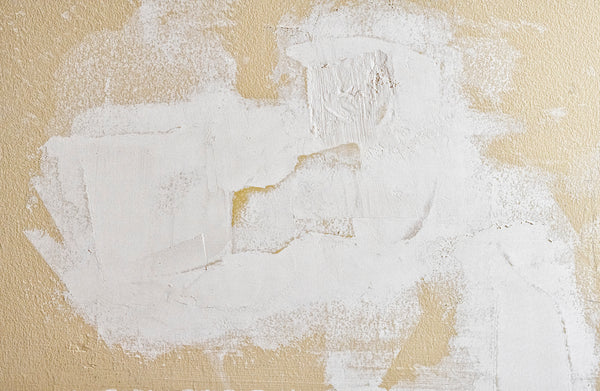How To Patch Drywall: Your Complete Guide

Jump to:
Drywall, which is also referred to as gypsum board, plasterboard, or wallboard, is a building material widely used in the interior walls of residential and commercial buildings. It consists of two layers of thick paper with gypsum plaster core (calcium sulfate dihydrate) sandwiched between them and has the advantages of easy installation, relatively low cost, and being a smooth surface that is capable of being finished or painted in a wide variety of ways.
In this article, we will look at the ways in which drywall can be damaged, proper maintenance to extend the lifespan of your drywall and prevent damage, and what to do when said maintenance fails and you need to repair drywall, as well as consider safety precautions and the process of repairing different-sized holes, including choosing the tools required for each job.
Ways In Which Drywall Can Get Damaged

Drywall can suffer impact damage, or be damaged by water, building settling, or temperature or humidity changes, causing dents, cracks, swelling, warping, or mold. Minor damage can also result from deficient installation techniques or everyday wear and tear caused by such activities as moving furniture or hanging pictures. It is also vulnerable to structural issues and pest infestations, like termites. Additionally, nails or screws that were not properly secured may pop out, creating visible defects. Proper maintenance and prompt repairs are essential to extend the lifespan of drywall and maintain the integrity of walls and ceilings.
What Is The Best Way To Maintain Drywall?
Given that prevention is always better than cure, before looking at ways of repairing drywall, let us consider how we can help prevent the damage occurring in the first place. There are several crucial steps to increasing the longevity and maintaining the appearance of your drywall. Firstly, regular dusting with a soft cloth or a vacuum with a brush attachment helps prevent small scale damage escalating over time. For deeper cleaning, if the paint or wallpaper can handle it, use a damp cellulose sponge with mild detergent. However, it is not naturally water-resistant so avoid saturating the walls.
Lack of water resistance is also particularly relevant when it comes to preventing water damage. Promptly address any leaks and dry and dehumidify areas exposed to water to avoid mold growth and structural issues.
It is necessary to catch problems, such as cracks, holes, termites, or signs of water damage early to prevent them from becoming major issues. If the drywall is placed in an area susceptible to impact damage, consider using corner guards to prevent edges from damage. Nail pops should be tapped back in, covered with joint compound, sanded, and repainted. Finally, seasonal checks for cracks due to temperature and humidity changes are essential to keep your drywall in top condition.
Repairing Drywall – Safety Precautions

Before starting drywall repair, it's crucial to know the placement of utilities in your home or office. Electrical wires tend to be attached to wall studs, so locate these studs before cutting, drilling, or nailing drywall. This prevents accidental damage to electrical wiring, which can pose significant safety risks. Use a stud finder or similar tool to accurately locate studs and avoid potential hazards.
Safety is paramount when working with drywall. Always wear protective gear including work gloves, goggles, and a dust mask. Drywall dust, composed of gypsum, resin, paper, silica, and other materials, can cause respiratory issues ranging from mild to severe in their level of seriousness. You will also need a respiratory mask rated FFP1 or higher, along with safety goggles and gloves, to protect yourself from dust and debris during repair and installation.
Work in a well-ventilated area to avoid inhaling fumes from compounds, paints, or adhesives used during the repair. Additionally, turn off power near electrical outlets or switches by shutting off the circuit breaker and use a voltage tester to confirm the power is off. This will help you prevent electrical shocks during the repair process.
Make sure all furniture and other decorations are cleared from the area to avoid damage and maintain cleanliness. Make sure any tools you use, such as utility knives, drywall saws, or drills, are in good condition to prevent accidents. Handle drywall sheets carefully to avoid sharp edges and use a straight edge for precise cuts. Follow manufacturer instructions for repair products or tools, and clean up thoroughly after the repair, disposing of waste materials according to local regulations.
Fixing Dents In Drywall

Before looking at fixing actual holes, we will first describe how to repair any small dents that appear in your drywall, which are both the most common type of damage, and the easiest to fix.
Fixing dents in drywall involves the use of several specific tools. The necessary tools include a utility knife to cut away any loose or damaged drywall (this one from Olfa will do the job nicely), a putty knife for applying joint compound or spackle, joint compound or spackle itself to fill in the dent, and sandpaper or a sanding sponge to smooth the surface once dried. Additionally, primer prepares the area for painting, while paint and a paintbrush or roller ensure the repaired spot matches the rest of the wall.
Once you have the tools ready, you can carry out the process as follows:
- Clean the area using the utility knife to remove any loose drywall or debris around the dent.
- Use a putty knife to apply joint compound or spackle into the dent, smoothing it to be level with the wall. Allow the compound to dry completely, in accordance with the manufacturer’s guidelines.
- Once dry, sand the area using sandpaper or a sanding sponge to create a smooth surface, blending the edges with the surrounding wall. If the dent is deep, apply a second coat of compound, let it dry, and sand it again.
- Finally, apply primer to the repaired area, let it dry, and then paint it to match the rest of the wall, ensuring a seamless finish.
How To Fix Small Holes In Drywall

There is no precise definition about what counts as a small hole, but for the purpose of this article it refers to a hole that can be covered with a small self-adhesive patch, and is not large enough to require a fresh sheet of drywall. To fix small holes in drywall, in addition to the tools used for fixing dents above, you will also need a drywall patch. The process for applying this is as follows:
- Apply a (usually self-adhesive) patch to the hole. Follow the instructions from the manufacturer of the patch kit when doing this.
- Use a putty knife to apply joint compound to the patch. Make sure that the entire patch is covered and that it blends in well with the adjacent wall section.
- Allow the joint compound or spackle to dry.
- Smooth the surface with sandpaper. In case of deeper holes, you may need to apply a second round of joint compound.
- Brush off any dust or debris
- Use primer to prepare the patch for painting
- Paint the patch to match the surrounding wall.
How To Fix Medium-Sized Holes In Drywall

If you are repairing a medium-sized hole up to about 1 to 4 inches in diameter, you might like to use a California drywall patch. This method is ideal for quick repairs, such as holes caused by doorknobs or accidental damage, where there is no need for additional backing or support, provided the surrounding drywall is in good condition. The process for doing this is as follows:
- Start by cleaning the hole and trimming any loose drywall with a utility knife.
- Cut a piece of drywall slightly larger than the hole and score the back about an inch from the edge of each side.
- Snap the gypsum on the edges while leaving the paper facing intact, creating the outer “wings.”
- Apply a thin layer of joint compound around the hole, press the patch into place, and smooth joint compound over the patch and "wings" to blend with the wall.
- Once dry, sand the area smooth, apply additional coats of compound if needed, and finish with primer and paint.
How To Fix Large Holes In Drywall

In addition to the various tools mentioned so far, you will need some additional tools to fix large drywall holes. These may include a carpenter’s square or tape measure, a pencil, a stud finder, drill, drywall screws, drywall tape,
The process for doing this is as follows:
- Prepare the area. Use the pencil to draw a square or rectangle around the hole.
- Use a drywall saw to cut along the lines
- Measure a piece of replacement drywall that is the same size as the removed square or rectangle.
- Check if there are any studs present using the stud finder. If there are they can be used as attachment points for the drywall.
- If there are no studs, attach furring strips (small pieces of wood) to either side of the hole with drywall screws.
- Fix the replacement drywall piece snugly against the studs or furring strips.
- Apply drywall tape over the seams.
- Use a putty knife to apply joint compound over the seams and/or screws.
- Let the compound dry completely and sand it smooth. Repeat as necessary until you have a smooth finish.
- Apply primer and allow to dry.
- When the primer dries, paint the area to match the rest of the wall.
Patience Is The Key
There may be times, such as when you have experienced major flooding or there is crack damage in the wall, where replacement is the better option than repair. Further, although I have hopefully laid out the steps in a clear manner, you should not be afraid to call a drywall specialist if it all gets too much!
Above all, patience is the key. Whenever the methods call for allowing the joint compound, primer, or paint to dry, failing to do so and rushing ahead can lead to a lot of wasted effort. As long as you follow the steps outlined in this post for each situation carefully, one by one, nothing should phase you too much.

0 comments